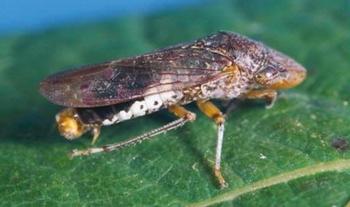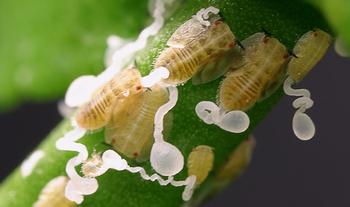What is that yellow trap in my tree?
-
James Campbell
-
Have you ever been out on a walk and seen a yellow panel trap attached to a tree? Maybe you have had a pest detection trap in your yard. Perhaps you are like me and wonder what these things are and who put them there. To get some answers, I spoke with Allison Klein, an Inspector with the County of Marin Department of Agriculture.
 If they don't get dirty, the traps stay sticky for about a month. Photo: California Department of Food and Agriculture
If they don't get dirty, the traps stay sticky for about a month. Photo: California Department of Food and AgricultureAllison shared that the 611 yellow panel traps placed and monitored around Marin County throughout the year are a cooperative effort between the Marin County Department of Agriculture and the California Department of Food and Agriculture. The pests targeted by these yellow traps are the Glassy-winged sharpshooter, which is monitored from March through October, and the Asian citrus psyllid, which is monitored from October through March.
You probably have noticed that traps seem to appear out of nowhere, they can also disappear, and that is because they get repositioned during the season to be sure a broad sampling is taken. Typically, a county trapper will knock on the homeowner's door to let them know they are placing a trap on or near a host plant. If contact cannot be made this way, the county trapper will set the trap in the front yard and leave the homeowner a letter notifying them of the trap placement, the trap type, and the location of the host plant. County trappers will never enter the backyards of properties without prior permission from the homeowner. Still, they may place a trap into or near a backyard from a front or side yard access or from a sidewalk.
The Glassy-winged sharpshooter is being monitored because it has already established a foothold in California. It was first observed in California around 1990 and now can be found in the entirety of Los Angeles, Orange, Riverside, Ventura, and San Diego counties. It can also be found in portions of Santa Barbara, Fresno, Kern, Imperial, and Tulare counties. The Glassy-winged sharpshooter is a particular threat to vineyards due to its ability to spread the bacterium Xylella fastidiosa, which causes Pierce's disease. The bacterium clogs the xylem, the water-conducting system in the plant, and causes the grapevine to die. The Glassy-winged sharpshooter can spread other diseases to both ornamental and agricultural plants giving it the potential to cause significant damage in California if left unchecked. The glassy-winged sharpshooter is a major threat to our wine industry. Photo: UC RegentsAsian citrus psyllid was discovered in California in 2008 and threatens all citrus varieties grown commercially and in the home garden. Asian citrus psyllid is widespread in Southern California and is found primarily in urban and suburban settings but has also been found in commercial groves. The psyllid has quickly expanded its range north into the Central Valley and Central Coast and has been seen as far north as areas around Sacramento and the San Francisco Bay area. It damages the tree directly by feeding on the leaves. Still more concerning is that the pest acts as a vector for the bacterium Candidatus Liberibacter asiaticus, which causes HLB disease, Huanglongbing, also known as citrus greening. This disease is eventually fatal to citrus, with no known cure. HLB attacks the citrus tree's phloem, the nutrient-conducting system in a plant, so the tree does not grow at the same rate as a healthy one, the canopies grow sparse, and eventually, it becomes unproductive for fruit.
The glassy-winged sharpshooter is a major threat to our wine industry. Photo: UC RegentsAsian citrus psyllid was discovered in California in 2008 and threatens all citrus varieties grown commercially and in the home garden. Asian citrus psyllid is widespread in Southern California and is found primarily in urban and suburban settings but has also been found in commercial groves. The psyllid has quickly expanded its range north into the Central Valley and Central Coast and has been seen as far north as areas around Sacramento and the San Francisco Bay area. It damages the tree directly by feeding on the leaves. Still more concerning is that the pest acts as a vector for the bacterium Candidatus Liberibacter asiaticus, which causes HLB disease, Huanglongbing, also known as citrus greening. This disease is eventually fatal to citrus, with no known cure. HLB attacks the citrus tree's phloem, the nutrient-conducting system in a plant, so the tree does not grow at the same rate as a healthy one, the canopies grow sparse, and eventually, it becomes unproductive for fruit. Asian citrus psyllids should be left on the tree and reported to the Marin County agricultural commissioner. Photo: UC Regents
Asian citrus psyllids should be left on the tree and reported to the Marin County agricultural commissioner. Photo: UC RegentsAllison added that the pest trapping and monitoring that the county conducts with the state is not our only line of defense. The County of Marin Department of Agriculture inspectors also conduct incoming plant quarantines. Plant shipments are monitored at retail and wholesale nurseries, aquatic supply stores, and FedEx and UPS. Of the 14,287 plant inspections performed in 2022, one hundred and eight were rejected.
We must remain vigilant about these invasive pests. It is a matter of when, not if, they will arrive in Marin County.



